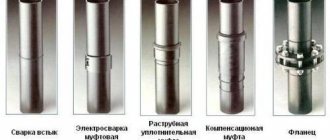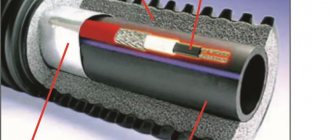If in winter, in severe frost, you open the water tap and the water does not flow, it means that the pipe is most likely frozen.
Why did this happen? This could happen for several reasons:
- the pipes were not buried sufficiently, they lie at the soil freezing level or above;
- low quality insulation or its absence;
- The water supply is turned off or the flow rate is very low.
If the pipeline is installed at a shallow depth and it is possible to access it, it is necessary to determine the area of freezing and thaw it.
The degree of freezing of pipes made of different materials
In a private house, water supply lines are made of plastic, metal or HDPE. They differ not only in quality, but also in the degree of freezing.
Plastic pipeline
Plastic water supply is made from various polymers, which explains the differences in physical and mechanical properties:
- polyethylene - suitable for external laying of water mains intended for household purposes or drinking;
- PVC products are characterized by a long service life and quick installation;
- profiled – resistant to sub-zero temperatures, since they are made from a combined material (polyethylene + propylene);
- spiral - are profile products with hollow polyethylene walls, used only for supplying water without pressure.
The main reason for freezing of plastic elements is improper laying of the line. If you install them above the ground freezing level, without taking into account the climatic conditions of the area, there is a risk of rupture.
Advice! If it is impossible to lay at a certain depth, it is necessary to organize a heating system.
HDPE highways
HDPE pipes are another type of plastic communications located in the ground. The reasons for freezing of the material are improper installation, laying at a depth of less than 2 m without taking into account the regional climate, low water consumption and poor-quality insulation.
Metal communications
Features of the steel tube are minimal coefficient of thermal expansion and mechanical strength. Manufacturers produce several types of elements:
- galvanized – thanks to the protective layer, the products are resistant to corrosion and are suitable for water supply and heating;
- seamless - produced by hot deformation, so when freezing they do not burst at the seams;
- water and gas pressure – used for water supply, selected according to the diameter and thickness of the walls;
- electric welded - low-alloy steel is used in production, which allows the use of water pipes for organizing steam heating.
The main reason for freezing is leaks caused by corrosion. It is easier to heat water in a metal pipe due to the long-term retention and distribution of heat by the material.
This is interesting: Staff tables: purpose and review of models
Heating technologies and pipe materials
There are more reliable methods for thawing ice in the water supply or sewer system. But when choosing a heating method, it is important to take into account the characteristics of the materials used during installation.
How to heat a metal-plastic pipe
Made from two-core copper wire with a cross-section of 2.5 mm
2
you can make something like a heating element. Making it yourself is quite simple:
- Separate and strip the wires from one end.
- Wrap both cores over the insulation on the wire itself in 3-5 turns.
- Mount a standard plug on the free end.
Pipe insulation diagram and heating cable laying
The main thing is that the turns of both branches of the heater lie parallel to each other and are at a distance of 2-3 mm, otherwise a short circuit will occur.
When the homemade “boiler” is ready, it is brought inside the water supply and plugged into an outlet. The current only heats water and melts ice, so this method is safe for metal-plastic pipes. As the plug thaws, the heating element moves deeper. But after passing each meter, it needs to be turned off and the melt water pumped out with a pump so that the water supply does not freeze again.
Heating of polypropylene pipes
Unlike metal-plastic, polypropylene pipes do not tolerate temperatures above +80...+ 90 ° C.
It will not be possible to heat them with a homemade heating element without harm to the system. Here you need controlled heat, and if the polypropylene water supply pipe is frozen, it is better to choose a gentle heating method.
You'll need an Esmarch mug, a flexible hose that can reach the ice jam, and plenty of hot water on hand. Insert the tip of the tube into the system and constantly fill the bulb, securing it higher. To make it easier to push the hose, screw it to a metal wire.
Be prepared for the water to flow back after some time, so place a container at the outlet in advance to collect it. As the plug gets smaller, the hose needs to be pushed deeper. It will take a long time to work, since heating occurs at a speed of about 1 m/h.
Pipe heating methods
To avoid having to warm up the entire water supply line, you should first determine the place where the pipe froze. On the surface and in unheated rooms, this is done by touch - at the freezing point, the plastic seems colder. Hint: the ice is pushing the pipeline from the inside, so find where it is clearly thickened to determine the extent of the emergency zone.
But if a pipe is frozen underground, it will be more difficult to find the freezing point. You will have to disassemble the connection closest to the exit and insert a flexible wire or plumbing cable inside. Gradually moving the “probe” along the pipe, you will reach the icing point. Place a mark on the wire at the edge of the hole, then pull it out and measure the length. Now it won’t be difficult to find the problem area.
Heating of the above-ground pipeline
The easiest way to thaw frozen water pipes is on the surface. Often this does not even require special equipment - a household hair dryer can handle this task if the system is barely caught in the frost. If pipes are seriously frozen, you need more powerful equipment like a construction thermo gun. Although hot air is simple and inexpensive, it should be used with caution. Excessive heat can cause plastic pipes to warp.
To avoid bending the water pipe, hot air is replaced with water. For such heating you need to stock up on simple materials and devices that are found in every home:
- foam mat or rags;
- a skein of twine or soft wire;
- container for boiling water and ladle.
Warming a frozen pipeline using hot water
The plastic pipe is wrapped in foam rubber along the entire freezing length and periodically spilled with water - first lukewarm, then with boiling water. In this case, each time you need to remove the flowing water from the floor so as not to cause a flood.
Heating underground pipes
Melting an ice plug in underground utilities is a more complex procedure and can take a long time. Not to mention you have to find the water pipe underground first.
The most primitive way of defrosting in this case is to make a fire on the surface above the water conduit. You will have to wait a long time, since first the ground will thaw, and only then the ice in the pipes. It’s good if this gives some result, but if the system still doesn’t work, you’ll have to dig a trench and do everything manually. The only advantage of this method is that warmed soil is easier to dig out than frozen soil.
When you reach the water supply pipe, assess its condition; it may require urgent repairs or partial replacement. And after you restore the water supply, fill the trench with insulation or empty PET bottles and fill it with earth. This will save you from further problems with pipes freezing.
Submersible pump and barrel to help
You will need a metal barrel, a bucket, a pump and a hose.
- The water in the barrel must be constantly heated. A fire or blowtorch will do.
- A hose from the pump is inserted into the water pipe. Thus, the water will flow out into the bucket through the gap between the tubes.
Scheme: defrosting pipes using hot water and a pump - The pump pumps water from the barrel into the pipe to the ice plug. As the ice melts, the hose is carefully pushed deep into the pipe until the ice plug is completely defrosted.
Advice. Propylene pipes are connected with fittings that do not narrow the internal diameter of the pipe at the joints, so the process of removing ice plugs is greatly simplified compared to pipes made of other materials.
Overview of different methods
The water supply can be defrosted using various methods of applying external heat to the pipe, or by defrosting it from the inside.
Method 1. Use hot water
If there is a suspicion that the water supply is frozen in an open area - at the entrance to the house, in an unheated basement, etc., boiling water is used to warm it up.
To do this, you must first wrap the pipe with any rag that will absorb water and prolong the time the pipe is in contact with boiling water. Pour hot water until the ice begins to melt. And to speed up the process, the tap must be left open.
The easiest way to warm a frozen pipe is to pour boiling water on it.
This method is used only indoors, because if the pipe is underground, it will take a long time to warm it with boiling water - at least 12 hours.
Method 2. Use a hair dryer
The pipe can be defrosted using hot air produced by a powerful hair dryer. The surface of the pipe is blown from all sides, and to reduce heat losses it is recommended to erect a small pavilion made of plastic film, for example, over the frozen pipe. If the pipe is plastic, you need to correctly calculate the heating so as not to melt it.
Solving the problem of defrosting a water pipe using a conventional hair dryer, but you can also use a construction tool
If the pipes freeze slightly, you can use a household hair dryer or fan heater to warm it up. If there are turns, narrowings, or entrances to fittings, they also need to be warmed up, as ice pieces can get stuck there. And in this case, do not forget to leave the tap open.
Method 3. Electric current comes to the rescue
How to warm a frozen water pipe using electric current?
Heating of a metal water supply can be done using a welding transformer: the positive wire is connected to one end of the pipe, and the negative wire to the second. In this simple way, the problem can be solved in a few minutes: the ice plug will melt.
The time for heating frozen metal water pipes with a welding transformer is minimal
Heating of a plastic pipeline can be done using a two-core copper wire with a cross-section of 2.5 mm. This method is similar to the operating principle of a conventional home boiler. The wire strands are disconnected. One of them is simply bent, and the second is exposed and twisted 3-5 turns around the wire, cutting off the excess end. They do the same with the first core, retreating 2-3 millimeters from the turns of the second core. You need to pay attention so that the wires do not touch, otherwise a short circuit will result. A plug is connected to the other end of the wire. The wire is pushed into a plastic pipeline and connected to the electrical network. Passing through the water, the current heats it up and the ice begins to melt.
The good thing about this method is that only the water heats up, while the wires remain cold and this prevents accidental melting of the plastic pipe. To quickly blow out melt water, you will need an additional compressor.
Method 4. We heat the pipeline from the inside using improvised means
How to heat a water supply system if it has many bends and sections? For such a case, you can build a special device. You will need a wire, a hydraulic level tube, an Esmarch medical mug (in simple terms - an enema), which consists of a rubber container with a rubber hose and a small tap for draining water. The hydraulic level tube is secured to the wire using electrical tape so that the end of the tube is slightly longer than the wire. Push it into the water supply until it stops. Hot water flows from the rubber reservoir into the pipeline. It is necessary to organize the collection of melt water.
Schematic representation of the warming process using wire and enema
As the ice thaws, the tube with the wire is pushed further. The process of heating a frozen water pipe using improvised means is quite labor-intensive and requires a lot of patience and time (about 1 hour per meter of frozen pipe), but the costs are minimal.
Method 5. Call specialists
You can also warm up a water pipe from the inside using special equipment - a hydrodynamic unit, the direct purpose of which is preventive flushing of water and sewer pipes.
Hot water with a temperature of 150 degrees is supplied under high pressure (90-100 atm) through the hose. The water boiler of the installation runs on diesel fuel, and the unit is powered by an electrical network with a power of at least 7 kW and a voltage of 380V. This method requires calling specialists, so this method is not suitable for everyone.
What are the causes of the problem
Freezing of water pipes can occur for various reasons. The main ones include the following:
1. The pipes were laid to a shallow depth, higher than the freezing layer of the soil.
2. The pipeline was not insulated during installation, or the material is of low quality.
3.they use little water, or its supply has been completely turned off.
Attention! When pipes are located near the surface of the earth, the frozen area should be cleared of soil in order to warm it up.
A method for determining the location of freezing. Before you use one of the methods for defrosting pipes, you should find the place where ice has formed. How to identify the damaged area:
1. inspect the pipeline upon entering the premises. This is the place that gets damaged most often.
2.inspect areas with applied thermal insulation; freezing may occur there because the insulation is damaged. The connection areas should be checked carefully.
3.inspect the entire pipeline. If the pipes are made of plastic, then an area with increased volume will indicate that there is an ice plug in this place.
4.check the area with your hands, if there is ice inside, the area will be colder, the outside of the pipe may become covered with frost.
5. If it is impossible to inspect the pipes, you should unscrew the tap and insert a plumbing cable into the pipeline. Use it to determine the size of the damaged area.
6. if the pipe has many twists, then it should be disassembled and inspected in an accessible place using a plumbing cable.
Attention! Several frozen areas may be found on the pipeline at once.
Internal heating of pipes
Let's consider what to do when the water in a pipe underground freezes. If the soil is shallow and not very hard, it is worth digging a trench and using the methods described above. If this is not possible, internal heating should be carried out. The main methods are based on the application:
- steam generator;
- homemade boiler;
- hot water.
All methods require the possibility of penetration into the pipeline. If it is missing, you should disassemble or cut out part of the structure, first turning off the water supply.
Steam generator
To defrost the pipe, you will need a steam generator - a device that produces hot water vapor under pressure. Stages:
- Fill the reservoir with water.
- Connect a heat-resistant hose with a small diameter to the steam generator.
- Insert the hose as far as it will go (until the ice plug) into the water pipe. At the same time, there should be free space in it for melt water to drain.
- Turn on the steam generator. Wait until the ice begins to defrost. This usually takes 5-15 minutes. It is necessary to monitor the amount of water in the steam generator tank.
When solving the problem of how to heat water in a plastic pipe underground, if there is no steam generator, you can use an autoclave. The heat-resistant hose should be connected to the fitting of the device.
Homemade boiler
You can warm up a plastic water supply using a homemade electric boiler. This method is not suitable for metal structures. It involves working with high voltage, so care must be taken.
Algorithm of actions:
- Take a copper wire with two insulated cores (cross section - 2.5-3 mm).
- Separate the wires and move them apart.
- Remove the winding from one wire. Bend the second core in the opposite direction along the wire.
- Wrap the “bare” part tightly 3-5 times around the fold. Trim off the rest.
- Depart from the turns 2-3 mm. Expose the end of the bent wire. Wrap it around the insulated wire 3-5 times. Trim off the excess part. The turns of the first and second wires should not touch.
- Attach a plug to the other end of the wire.
- Insert the “boiler” into the water supply until it stops.
- Plug the plug into the socket. When exposed to heat, the ice should begin to melt.
- As the plug decreases, the “boiler” should be moved deeper.
A mobile steam generator will help heat a pipe in the ground in a fairly quick time
Tip: When using a steam generator or “boiler”, you should ensure the outflow of melt water. It is necessary to periodically turn off the device and use a thin hose and compressor to pump it out of the pipe.
Brine
Brine is used to neutralize ice in pipes. To do this you need to prepare a strong solution. Water and salt are mixed in a ratio of 3 tablespoons per 1 liter of water. It is advisable that the liquid be at room temperature.
To complete the work you will need:
- Esmarch's irrigator;
- hydraulic level;
- tempered steel wire.
You need to do the following:
- The hydraulic level tube and steel wire are connected along the length. The end can be bent to provide greater rigidity to the flexible structure. In this case, the edge of the hose should protrude slightly beyond the bend of the wire.
- The second end of the tube is connected to Esmarch's mug.
- The hose is gradually inserted into the plastic/polypropylene/metal water supply system until it stops at the plug.
- Esmarch's mug is filled with brine and raised up. The brine solution flows into the line and gradually defrosts/corrodes the ice. Water must be constantly added to the enema.
It is advisable to place a bucket under the tap into which melt water will flow. The system must be kept open during work. As soon as the freezing point is overcome, the water will flow by gravity.
This is interesting: The use of antifreeze
We use a steam generator
A steam generator is a special machine that regenerates steam and supplies it under pressure. The fitting is inserted into the water pipe and hot steam melts the ice plug. This is the most effective and fastest way to clear an ice jam. There is only one drawback - not every home has such a device. But if you have a double boiler or autoclave, they can also be used for heating. When using them, the procedure is as follows:
You can use a steam generator to defrost the water supply.
- Pour water into one of the listed units.
- One end of the heat-resistant hose is connected to the autoclave fitting.
- We push the other end into the water pipe to the freezing point.
- Turn on the heating device and wait for the result.
- We monitor the water level in the autoclave.
Measures to prevent pipeline freezing
At the first opportunity, when warm weather sets in, it is necessary to take measures to insulate the water supply in order to avoid such a nuisance in the future. Deformed areas will need to be replaced.
- Water supply pipes are laid below the freezing level of the soil.
- The pipe is wrapped in high-quality thermal insulation; if necessary, an additional heating cable is laid along the pipe.
Insulation of water pipes - The places where the pipe passes through the foundation are additionally insulated, since concrete freezes faster than soil. The pipe is placed in a pipe of larger diameter and foamed with polyurethane foam.
- The basement pipes are wrapped in thermal insulation: mineral wool, glass wool, or a special insulation for pipes in the form of a cylinder.
But while the frost is crackling outside, not all insulation methods can be used, and there is no point in chiseling the frozen ground. We can recommend one effective action - although this is a violation of safety rules: keep the tap slightly open so that the water flows in a small thin stream, and then the moving water stream will not allow ice to form.
Conclusion
Having analyzed the above information, we can conclude that the best way to avoid pipe rupture is to insulate them using polyurethane foam shells. This is the most budget-friendly, simple and reliable option among the above. The main thing is that the material is of high quality.
You can order high-quality polyurethane foam shells from the AMARO company. We are a direct manufacturer of polyurethane foam shells, thanks to which the products have a favorable price for customers.
Order form for PPU shells (thermal insulation for pipes), bends, glue, casings, clamps
Using this form, you can submit an order request for pipe insulation (PPU shell, thermal insulation), pipe bends, glue, clamps and any of our other products. After processing the order by our sales department, employees will contact you to clarify the order parameters, delivery times, delivery conditions, etc.
Heating pipes using hot water
This method is best suited for cases where the trench where the pipe is located can be easily opened. For example, it is not buried underground, but is located in a concrete channel, which is not a problem to quickly access. In addition, this technology is only suitable for steel pipelines. The frozen section of the pipe is first wrapped in rags and then poured with boiling water. In a relatively short period of time, you can warm up a frozen area.
When heating pipes with hot water, it is important not to damage them. Areas that do not require heating must be covered with heat-insulating material, otherwise ice may form elsewhere.
Heating with an open fire
This method is used only for frozen steel pipes. When working, you need to use a blowtorch or a gas burner; if these tools are not available, you can use a regular fire. Important tip: you need to put a sheet of metal under the pipe so that the heat is reflected better. The frozen part of the pipeline is heated by an open fire, and the resulting water gradually spreads throughout the system. This method is used only when pipes are visible.
Warming up a frozen pipeline with a hairdryer
A hair dryer can quite successfully remove ice plugs. However, this heating method can only be used in situations where the pipeline is easy to reach. For example, in cases where it is located inside a building. This technology is not suitable for pipes made of polymer materials, because a construction hair dryer produces too high a temperature. In the worst case, the plastic will melt and the water supply system will have to be changed.
The metal pipeline can be warmed up with a hairdryer, but this will take quite a lot of time. This process can be accelerated by using a sleeve made of any dense material, for example polyethylene. The sleeve is placed on the desired area, and a hair dryer is inserted inside it and connected to a power source. Heated air collects in the sleeve, which acts on the pipeline, heating it evenly over the entire surface.
Defrosting pipes using a welding machine
This technology for heating pipes was invented by savvy owners of private houses. The method consists of applying electricity to the frozen area from a welding machine. Depending on the degree of freezing, the current can be adjusted down or up. The wires from the welding machine are connected to the ends of the frozen section and wrapped with wire. The equipment is then turned on for about half a minute. After a short break, this process is repeated. If during such exposure the pipe does not heat up, the current of the device is increased.
Industrial systems for defrosting pipelines operate on this principle. The terminals of this device are connected to the ends of the area that needs to be defrosted. The device is plugged into the network and a current is applied to the pipe. Using such a device, a pipe 25 meters long and 6 centimeters in diameter defrosts in about 1 hour, therefore, if the structure has a diameter larger than 6 centimeters, it is better to defrost it in separate parts, it will be faster.
Equipment for emergency defrosting
The most famous equipment for emergency defrosting of pipes at the moment is the “Dragon”. This device is recognized by professionals as one of the best for removing ice from a pipe. This device is a step-down transformer with a high transformation rate. Depending on the model, this device can deliver a current of up to 400 Amps, due to which you can very quickly heat up a frozen pipe.
The advantages of this system include a high level of fire safety when performing pipeline defrosting work, an effective system of protection against electric shock to a person or animal, and the presence of a built-in regulator that allows you to select the optimal ratio of thermal power. In addition, “Dragon” can operate from a classic household network; to do this, you need to reduce the load by reducing the current.
If you plan to heat a large pipe over a long section, it is recommended to use several of these devices at the same time. Before using the system, check for excess pressure in the pipeline structure; this is necessary to start water circulation during the heating process.
Special pliers, connected to the device using a cable of the required length, are installed at the ends of the frozen section of the pipe, then the device is turned on and all you have to do is wait. The pipeline defrosting process can take from 3 minutes to 1 hour. It all depends on the amount of ice formed.
How to warm up a plastic pipe
Above we presented methods for heating metal structures, but what about plastic pipelines? To do this, you can use moderately hot water (no more than 80 degrees Celsius) or use a heating cable. With hot water heating technology, everything should be clear, but most owners of private houses have not even heard of a heating cable. In order to defrost a section of pipe with a cable, you need to wrap it with metal foil.
A special heating cable is wound on top of the foil. You should be careful, in order to avoid cable failure, the turns of the system must be located at a distance of at least 9 centimeters from each other. Thermal sensors are installed on the heating cable, which turn off the system when heated to a certain temperature. The cable is connected to a power source and heats up the desired area.
Tips for thawing frozen drains
In order to defrost the sewer, you can also use steam - here it will be easier. There is another interesting way, but it will take a significant amount of time. It is necessary to make a steep saline solution in boiling water, which is poured into the sewer. Salt is known to promote melting. The only problem is that in this way you can achieve results both in a couple of hours and in a couple of days.
PHOTO: ranpress.ru Sewer pipes can also freeze
The best option would be to use a steamer and a hose, just like with a water pipe.
If the pipes are filled with water: use of electricity
In order to use this method, you need to purchase a special heating cable designed specifically for such situations. This equipment will do the job very quickly. Such a cable will never be superfluous, which means it is best to purchase it in advance, its cost is low.
You can make it yourself. You can find out how to do this by watching the short video at the end of the article.
PHOTO: zona-tepla.ru It’s good if you have a similar factory-made heating cable at hand
And one more piece of advice. On frosty nights, it is better not to turn off the water completely, but to leave a thin stream. Running water will prevent either the mains or the sewer from freezing.
PHOTO: aqua-rmnt.com Even the meter doesn’t perceive this trickle of water – it doesn’t turn it











